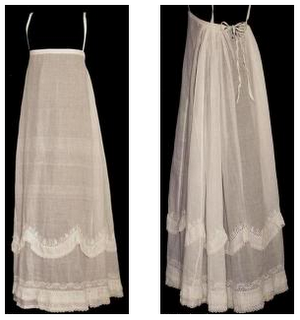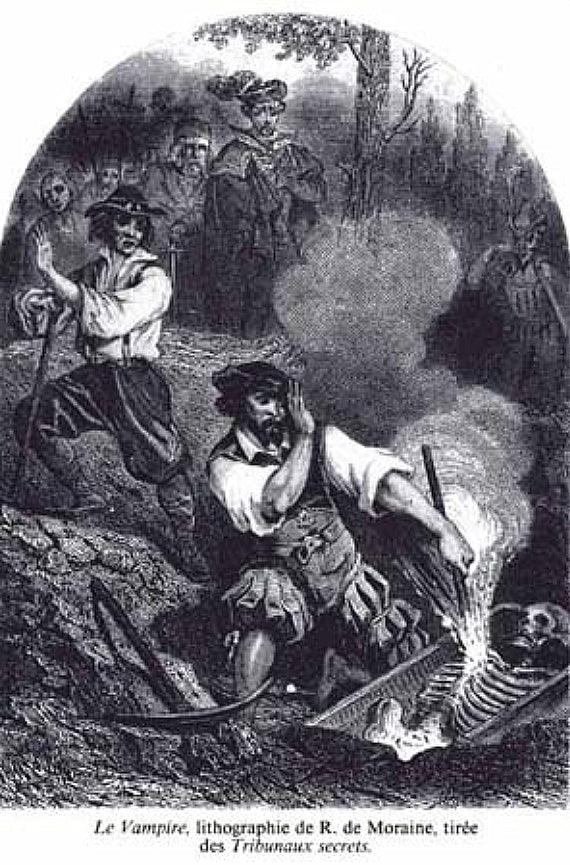Regency Petticoats: What Were They Like?
A petticoat or underskirt is an article of clothing for women; specifically an undergarment to be worn under a skirt or a dress. The petticoat is a separate garment hanging from the waist (unlike the chemise which is more shirt like in nature, and hangs from the shoulders.) In historical contexts (sixteenth to mid-nineteenth centuries),
petticoat refers to any separate skirt worn with a gown, bedgown, bodice or jacket; these petticoats are not, strictly speaking, underwear as they were made to be seen. In both historical and modern contexts,
petticoat refers to skirt-like undergarments worn for warmth or to give the skirt or dress the desired fashionable shape.*

A highly decorative Regency petticoat, complete with shoulder straps to help it stay in place. Note the plain front and gathered back. From the
Oregon Regency Society
Prior to the Regency, any number of petticoats might be worn under a gown, with the outermost layer often meant for display, like the elaborate underskirt worn in this portrait:

Naturally, these Regency petticoats would fasten at the waist, however, the connical shape of Regency gowns, not only meant a reduced number of petticoats (one to five) mostly meant to stay hidden, they also had to fasten as high as the bust to accommodate the raised waistline. Some petticoats were even "bodiced", including a bust support, which could even be worn in lieu of stays. As in any era, having the correct underpinnings was paramount to carrying off the fashion of the day.
To this end, a woman would wear a shift or chemise (she might even sleep in it), a sort of long, short sleeved shirt, which would be soft, and made of cotton. This would protect her dresses from perspiration, body oil, etc. Over this would go the corset, if worn (actually called stays at the time.) Corsets fell from favor during the fashion revolution of the 1790's, but returned in a shortened form in the early 1800's. Finally, over this would go the petticoats.

Given the rage at the time for light, sheer fabrics, petticoats added necessary warmth, as well as a degree of modesty, though there was also trend for pastel colored petticoats worn under transparent muslin gowns, like this fashion plate from
Costume Parisien:

Some ladies even went to the extreme of dampening their gowns to allow the petticoat, and/or underlying figure to be more fully revealed. While this may be presented as "typical" in some Regency-set novels, and even fall in line with Austen's comment about Mrs. Powlett being, "at once expensively and nakedly dressed" (January 8, 1801) this was more likely the exception than the rule. As Vic Sanborn points out, in her article on
Petticoats and Chemises, "The unusual (and rare) practice of dampening one’s gown at the turn of the century was most likely followed by light-o-loves, courtesans, ladybirds, cyprians, and women of ill repute. Aristocratic women who were confident in their unassailable status might have gotten away with such licentious behavior on a dare, and their fashion inclinations might have been considered “au courant”, but no proper lady, no young miss on the marriage mart, no merchant’s daughter looking to improve her station in life, would for a moment consider walking out in public without the protection of a chemise or petticoat, much less wet her gown to make it more revealing. While caricaturists showed enormous zest in depicting the new revealing fashions, they exaggerated the trend of these flimsy gowns out of all proportion in their visual commentaries."
 The Three Graces in High Wind
The Three Graces in High Wind
Although considered "underwear", Jane Austen often mentions petticoats in her letters, and who can forget Elizabeth Bennet's arrival at Netherfield, with her petticoat "six inches deep in mud". According to Henry Churchyard's
notes on Pride and Prejudice, this "petticoat would have been slightly shorter than the outermost layer (the gown), and made of a coarser, cheaper, and easier-to-wash material than the gown, so that when Elizabeth walked through the mud, she would have lifted up her gown and let the petticoat underneath take the brunt of the dirt (thus protecting the gown, while still being decently covered down to near her ankles; at that time, the lower part of the outer petticoat was not really considered underwear, and was often decorated in the expectation of its being publicly seen). The idea was that when she arrived at Netherfield, she could let down the down the gown (the outermost and most fragile layer that she had been trying to preserve) so that it would cover the muddy petticoat, and she would have a more presentable (externally undirtied) appearance."

In writing to her sister, Cassandra, Jane comments, "I have read [Byron's] The Corsair , mended my petticoat, and have nothing else to do." (March 5, 1814 )...thereby lumping Byron's epic poem in with the mundane details of life, like mending. In another letter, she writes that she will soon be turning a worn gown into a petticoat, thrift and economy becoming the mother of invention.
I am full of joy at much of your information...that you should meditate the purchase of a new muslin gown, are delightful circumstances. I am determined to buy a handsome one whenever I can, and I am so tired and ashamed of half my present stock, that I even blush at the sight of the wardrobe which contains them. But I will not be much longer libelled by the possession of my coarse spot; I shall turn it into a petticoat very soon.
December 24, 1798
All in all, the Regency petticoat provided warmth and a visual barrier against the thin muslins of the era (recall that underdrawers were the exception, not the rule, at this time.) To again quote from Vic Sanborn,"The primary purpose of these undergarments was to protect the delicate outer garment from soiling. In Regency times people did not wash themselves frequently, and petticoats and chemises presented a barrier between unwashed and sweaty skin and the dress. Since undergarments were made of sturdier fabrics, they could be laundered more often. In addition, people with less means owned fewer gowns and employed fewer servants to do the laundering. Even these ladies owned a number of chemises (usually homemade) and petticoats that could be washed frequently, thereby protecting their every day AND special gowns.
 A highly decorative Regency petticoat, complete with shoulder straps to help it stay in place. Note the plain front and gathered back. From the Oregon Regency Society
Prior to the Regency, any number of petticoats might be worn under a gown, with the outermost layer often meant for display, like the elaborate underskirt worn in this portrait:
A highly decorative Regency petticoat, complete with shoulder straps to help it stay in place. Note the plain front and gathered back. From the Oregon Regency Society
Prior to the Regency, any number of petticoats might be worn under a gown, with the outermost layer often meant for display, like the elaborate underskirt worn in this portrait:
 Naturally, these Regency petticoats would fasten at the waist, however, the connical shape of Regency gowns, not only meant a reduced number of petticoats (one to five) mostly meant to stay hidden, they also had to fasten as high as the bust to accommodate the raised waistline. Some petticoats were even "bodiced", including a bust support, which could even be worn in lieu of stays. As in any era, having the correct underpinnings was paramount to carrying off the fashion of the day.
To this end, a woman would wear a shift or chemise (she might even sleep in it), a sort of long, short sleeved shirt, which would be soft, and made of cotton. This would protect her dresses from perspiration, body oil, etc. Over this would go the corset, if worn (actually called stays at the time.) Corsets fell from favor during the fashion revolution of the 1790's, but returned in a shortened form in the early 1800's. Finally, over this would go the petticoats.
Naturally, these Regency petticoats would fasten at the waist, however, the connical shape of Regency gowns, not only meant a reduced number of petticoats (one to five) mostly meant to stay hidden, they also had to fasten as high as the bust to accommodate the raised waistline. Some petticoats were even "bodiced", including a bust support, which could even be worn in lieu of stays. As in any era, having the correct underpinnings was paramount to carrying off the fashion of the day.
To this end, a woman would wear a shift or chemise (she might even sleep in it), a sort of long, short sleeved shirt, which would be soft, and made of cotton. This would protect her dresses from perspiration, body oil, etc. Over this would go the corset, if worn (actually called stays at the time.) Corsets fell from favor during the fashion revolution of the 1790's, but returned in a shortened form in the early 1800's. Finally, over this would go the petticoats.
 Given the rage at the time for light, sheer fabrics, petticoats added necessary warmth, as well as a degree of modesty, though there was also trend for pastel colored petticoats worn under transparent muslin gowns, like this fashion plate from Costume Parisien:
Given the rage at the time for light, sheer fabrics, petticoats added necessary warmth, as well as a degree of modesty, though there was also trend for pastel colored petticoats worn under transparent muslin gowns, like this fashion plate from Costume Parisien:
 Some ladies even went to the extreme of dampening their gowns to allow the petticoat, and/or underlying figure to be more fully revealed. While this may be presented as "typical" in some Regency-set novels, and even fall in line with Austen's comment about Mrs. Powlett being, "at once expensively and nakedly dressed" (January 8, 1801) this was more likely the exception than the rule. As Vic Sanborn points out, in her article on Petticoats and Chemises, "The unusual (and rare) practice of dampening one’s gown at the turn of the century was most likely followed by light-o-loves, courtesans, ladybirds, cyprians, and women of ill repute. Aristocratic women who were confident in their unassailable status might have gotten away with such licentious behavior on a dare, and their fashion inclinations might have been considered “au courant”, but no proper lady, no young miss on the marriage mart, no merchant’s daughter looking to improve her station in life, would for a moment consider walking out in public without the protection of a chemise or petticoat, much less wet her gown to make it more revealing. While caricaturists showed enormous zest in depicting the new revealing fashions, they exaggerated the trend of these flimsy gowns out of all proportion in their visual commentaries."
Some ladies even went to the extreme of dampening their gowns to allow the petticoat, and/or underlying figure to be more fully revealed. While this may be presented as "typical" in some Regency-set novels, and even fall in line with Austen's comment about Mrs. Powlett being, "at once expensively and nakedly dressed" (January 8, 1801) this was more likely the exception than the rule. As Vic Sanborn points out, in her article on Petticoats and Chemises, "The unusual (and rare) practice of dampening one’s gown at the turn of the century was most likely followed by light-o-loves, courtesans, ladybirds, cyprians, and women of ill repute. Aristocratic women who were confident in their unassailable status might have gotten away with such licentious behavior on a dare, and their fashion inclinations might have been considered “au courant”, but no proper lady, no young miss on the marriage mart, no merchant’s daughter looking to improve her station in life, would for a moment consider walking out in public without the protection of a chemise or petticoat, much less wet her gown to make it more revealing. While caricaturists showed enormous zest in depicting the new revealing fashions, they exaggerated the trend of these flimsy gowns out of all proportion in their visual commentaries."
 The Three Graces in High Wind
Although considered "underwear", Jane Austen often mentions petticoats in her letters, and who can forget Elizabeth Bennet's arrival at Netherfield, with her petticoat "six inches deep in mud". According to Henry Churchyard's notes on Pride and Prejudice, this "petticoat would have been slightly shorter than the outermost layer (the gown), and made of a coarser, cheaper, and easier-to-wash material than the gown, so that when Elizabeth walked through the mud, she would have lifted up her gown and let the petticoat underneath take the brunt of the dirt (thus protecting the gown, while still being decently covered down to near her ankles; at that time, the lower part of the outer petticoat was not really considered underwear, and was often decorated in the expectation of its being publicly seen). The idea was that when she arrived at Netherfield, she could let down the down the gown (the outermost and most fragile layer that she had been trying to preserve) so that it would cover the muddy petticoat, and she would have a more presentable (externally undirtied) appearance."
The Three Graces in High Wind
Although considered "underwear", Jane Austen often mentions petticoats in her letters, and who can forget Elizabeth Bennet's arrival at Netherfield, with her petticoat "six inches deep in mud". According to Henry Churchyard's notes on Pride and Prejudice, this "petticoat would have been slightly shorter than the outermost layer (the gown), and made of a coarser, cheaper, and easier-to-wash material than the gown, so that when Elizabeth walked through the mud, she would have lifted up her gown and let the petticoat underneath take the brunt of the dirt (thus protecting the gown, while still being decently covered down to near her ankles; at that time, the lower part of the outer petticoat was not really considered underwear, and was often decorated in the expectation of its being publicly seen). The idea was that when she arrived at Netherfield, she could let down the down the gown (the outermost and most fragile layer that she had been trying to preserve) so that it would cover the muddy petticoat, and she would have a more presentable (externally undirtied) appearance."
 In writing to her sister, Cassandra, Jane comments, "I have read [Byron's] The Corsair , mended my petticoat, and have nothing else to do." (March 5, 1814 )...thereby lumping Byron's epic poem in with the mundane details of life, like mending. In another letter, she writes that she will soon be turning a worn gown into a petticoat, thrift and economy becoming the mother of invention.
In writing to her sister, Cassandra, Jane comments, "I have read [Byron's] The Corsair , mended my petticoat, and have nothing else to do." (March 5, 1814 )...thereby lumping Byron's epic poem in with the mundane details of life, like mending. In another letter, she writes that she will soon be turning a worn gown into a petticoat, thrift and economy becoming the mother of invention.


